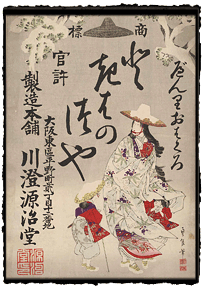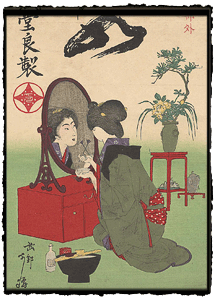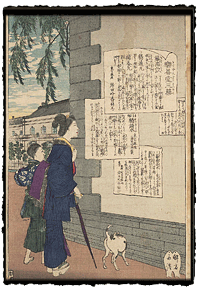|
Drug Advertisements
Page 2 of 2
Many of the later
advertisements are for products suitable for women: iron pills, "monthly cleansing" pills, and
various cosmetic products, including tooth-blackening powder. The latter was a traditional treatment to
enhance appearance, developed before modern dentistry assured that most people
retained their teeth to adulthood; tooth-blackening, or ohaguro, was still in use even
during the Meiji period by some married women, and by geisha.
 An early twentieth-century
print from the collection advertises the "easy to use tooth-blackening oxide Tokiwa
tsuyu." The product name Tokiwa tsuyu,
roughly translating to "everlasting luster," also contains a reference to one
of the foremost women of Japanese legend, Tokiwa Gozen. Gozen is best known today as the mother of famed warrior Minamoto no Yoshitsune
(1159-89). An early twentieth-century
print from the collection advertises the "easy to use tooth-blackening oxide Tokiwa
tsuyu." The product name Tokiwa tsuyu,
roughly translating to "everlasting luster," also contains a reference to one
of the foremost women of Japanese legend, Tokiwa Gozen. Gozen is best known today as the mother of famed warrior Minamoto no Yoshitsune
(1159-89).
According to the Tales of the Heike, an account of the
momentous clash between the Minamoto and Taira military clans, following the death of clan leader
Yoshitomo, his mistress Gozen was forced to flee
through the snow with her three children.
The advertisement makes use of this imagery, by representing Gozen in elegant court-style robes, walking through the
snow with a baby to her breast and two other children beside her. The ad suggests that by using this product a
woman could not only produce a lustrous smile, but also possess the beauty and
virtue of Gozen herself.
 An ad for the base liquid
used in tooth blackening shows a woman examining her teeth in an oval mirror,
cup in one hand and tooth-blackening brush in the other, with a bottle with the
liquid on the floor nearby. A glimpse of
the red under-robe at her collar, sleeves, and below her knee signals to
viewers that she is one of the elite geisha,
not an ordinary housewife. An ad for the base liquid
used in tooth blackening shows a woman examining her teeth in an oval mirror,
cup in one hand and tooth-blackening brush in the other, with a bottle with the
liquid on the floor nearby. A glimpse of
the red under-robe at her collar, sleeves, and below her knee signals to
viewers that she is one of the elite geisha,
not an ordinary housewife.
A series of advertisements by Eitaku (1843-1890) reflect the new, modernized
image of Japan
emerging by the late 1880s, in which advertising was an increasingly prominent
feature of daily life. The prints
promote a set of three drugs from Rakuzendo, treating
low energy, heartburn, and constipation, yet their illustrations contain no
hint of these conditions, nor are the medicines or their effects
personified.
 Two of the prints feature
elegant young women in traditional interiors furnished with painted scrolls and
screens "decorated" with messages advertising the products. The other two are set outdoors and suggest,
perhaps playfully, that such ads were an inescapable feature of modern
life: in one, a young women and
two men (one dressed in Western clothing including a deerstalker hat and
striped pants) look up at an enormous stele carved with information about the
three drugs; in the other (shown at right) a woman and young girl stand reading advertisements
plastered to the wall of a Western-style masonry building. Two of the prints feature
elegant young women in traditional interiors furnished with painted scrolls and
screens "decorated" with messages advertising the products. The other two are set outdoors and suggest,
perhaps playfully, that such ads were an inescapable feature of modern
life: in one, a young women and
two men (one dressed in Western clothing including a deerstalker hat and
striped pants) look up at an enormous stele carved with information about the
three drugs; in the other (shown at right) a woman and young girl stand reading advertisements
plastered to the wall of a Western-style masonry building.
|
|
View by Theme
|

